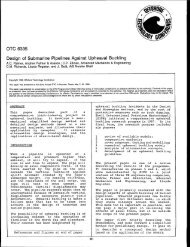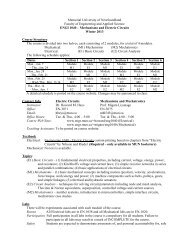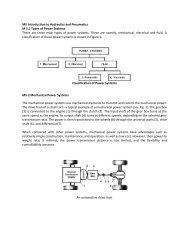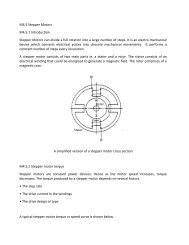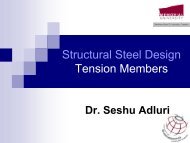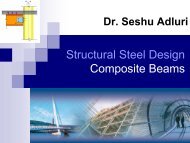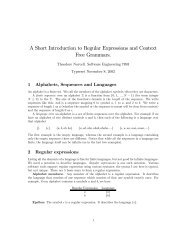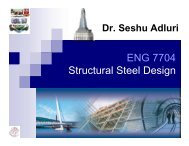5003 Lectures - Faculty of Engineering and Applied Science
5003 Lectures - Faculty of Engineering and Applied Science
5003 Lectures - Faculty of Engineering and Applied Science
You also want an ePaper? Increase the reach of your titles
YUMPU automatically turns print PDFs into web optimized ePapers that Google loves.
E<strong>5003</strong> - Ship Structures I 164<br />
© C.G. Daley<br />
dy = d + f x , d , d , d ) (why is this more<br />
2<br />
( 3 5 6<br />
complex?)<br />
For this beam element, we made use <strong>of</strong> what is<br />
called ‘beam theory’, to solve for the loads <strong>and</strong><br />
deflections under certain loading conditions.<br />
However, in the case <strong>of</strong> most finite elements, such<br />
as 2D planar elements, plate elements, <strong>and</strong> solid<br />
elements, we will not start from some general<br />
analytical solution <strong>of</strong> a loaded membrane, plate or<br />
solid. These solutions are too complex <strong>and</strong> will not<br />
give practical results. Instead, we assume some<br />
very simple behaviors, highly idealized, but which<br />
satisfy the basic requirements for equilibrium (i.e.<br />
forces balance, energy is conserved). With this<br />
approach, the single element does not really model<br />
the behavior or a comparable real solid object <strong>of</strong><br />
the same shape. This is ok, because the aggregate<br />
behavior <strong>of</strong> a set <strong>of</strong> these simple elements will<br />
model the behavior quite well. This is something<br />
like modeling a smooth curve as a series <strong>of</strong><br />
straight lines (even horizontal steps). This is<br />
locally wrong, but overall quite accurate.<br />
Constant Stress Triangle<br />
To illustrate the way that finite elements are<br />
formulated, we will derive the full description <strong>of</strong><br />
an element called the constant stress triangle (cst).<br />
This is a st<strong>and</strong>ard 2D element that is available in<br />
most finite element models.<br />
Consider a 2D element which is only able to take<br />
in-plane stress. The three corners <strong>of</strong> the triangle<br />
can only move in the plane.<br />
For this element the force balance is;<br />
δ<br />
e<br />
F = K<br />
6x 1 = 6x6<br />
6x1<br />
{ } [ ]{ }<br />
We want to determine the element stiffness matrix<br />
Ke , <strong>and</strong> we want it to be valid for any triangle;





